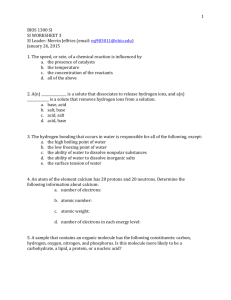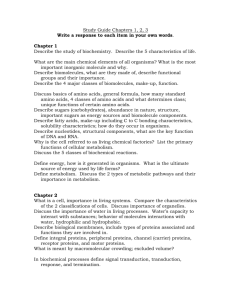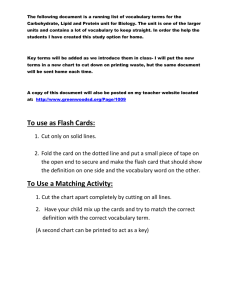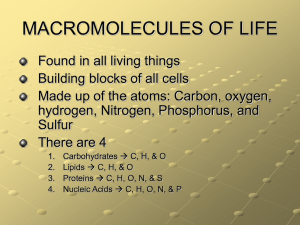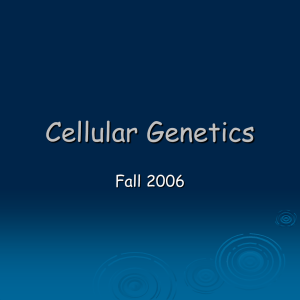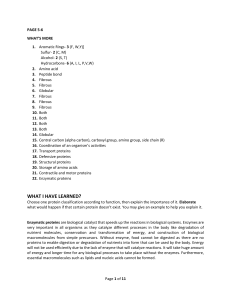Cell Chemistry
advertisement
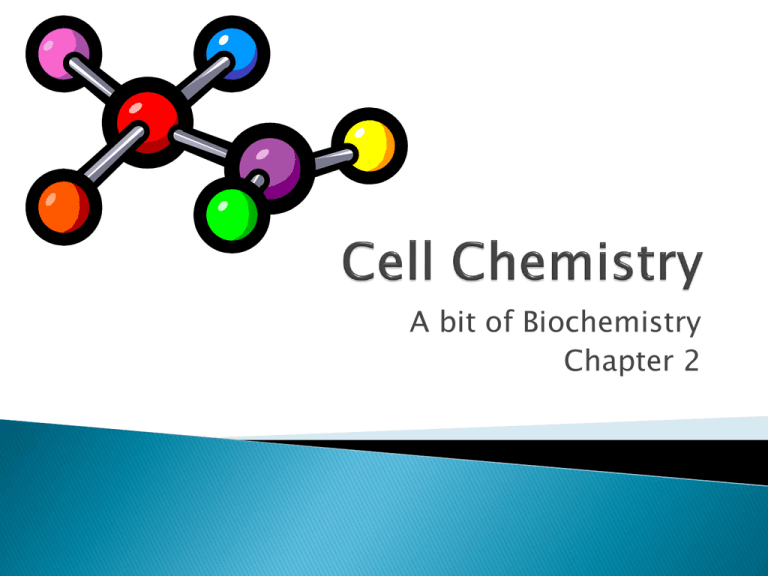
A bit of Biochemistry Chapter 2 List the major chemical elements in cells. Identify the function of the four major molecules or compounds in cells. Explain the role of enzymes in cells. Formed by joining smaller molecules together. Polymers have small sections joined together in long chains. Carbohydrates- provide energy Lipids- protect, insulate, regulate Proteins - build structure, transport oxygen, contract muscles, immunity ◦ Enzymes- proteins that speed up formation or breakdown of compounds. Nucleic Acids- chemical code for all body parts, compounds, and functions Made of carbon, hydrogen, and oxygen Simple sugars called monosaccharides ◦ Fructose – C6 H12 O6 ◦ Glucose ◦ Galactose Disaccharides- made of two monosaccharides. ◦ Sucrose- Dehydration, or removing water builds disaccharides Adding water Breaks Disaccharides, and is called hydrolysis Drink water when eating carbohydrates. Up to 4000 glucose units longs Few side chains Flour, Pasta, Potatoes, Cake Plant cellulose is found in plant cell walls, has links between parallel chains, which doesn’t let us digest it. It passes through as fiber. Glycogen, sugar stored in animal tissues, but is not muscle. http://www.bi o.brandeis.edu /classes/bio18 /glycogen.gif The round head is phosphate and is polar The tail is nonpolar fatty acids. Cause fats to mix with water as one end is polar and the other is non-polar. Digestive bile emulsifies fats in the liver Have little Oxygen C53H133O3 Fats- solid at room temperature Oils- liquid at room temperature Saturated fats- have tails with single bonds between carbon atoms Unsaturated- have tails with double bonds between carbon atoms Polyunsaturated- more than one double bond Necessary in small does in your brain ◦ Linolenic acid (ALA) ◦ Docosahexaenoic acid (DHA) ◦ Eicosapentaenoic acid (EPA) Sources Salmon Sardines Make up hair, skin, nails, muscle, cartilage, hormones that regulate body processes The order and type of amino acids determines the behavior or look of the protein Keratin- hair, nails Collagen- support ligaments, tendons, skin Enzymes- speed reactions, work at 37°C Transport- Carriers in cell membrane, Hemoglobin transports Oxygen Defense- antibodies fight infection by combining with antigens and prevent antigens from destroying cells. Hormones- regulate growth, intercellular messengers, influence metabolism Motion- actin and myosin contract muscles https://www.youtube.com/watch?v=M568QP 1K3sM Primary: order of amino acids Secondary: Spiral or Pleated shapes due to hydrogen bonding Tertiary: 3D shape due to hydrophilic or hydrophobic amino acids. Covalent, Ionic, and Hydrogen bonding. Quaternary: 2 proteins associate together. Name ends in –ase ◦ DNA polymerase, Sucrase, Lipase Enzyme is a protein shaped like a puzzle that will only fit a certain chemical. When the two attach, the Enzyme will either join two chemicals or split a chemical in two parts, then release it and do the same process with another chemical. ◦ Animation http://highered.mcgrawhill.com/sites/0072507470/student_view0/chapter25/a nimation__enzyme_action_and_the_hydrolysis_of_sucros e.html Can change with temperature or pH level. ◦ Lab Enzyme in Potato on Hydrogen Peroxide in cold, room temp, and boiling temperatures. http://highered.mcgrawhill.com/sites/0072495855/student_view0/c hapter2/animation__how_enzymes_work.html Heat can change the shape of proteins Vinegar + Milk Curdling, Cheese Heat coagulates egg white protein called albumin. Alzheimers and Mad Cow Disease are result of proteins being changed in shape. They transmit our genetic traits from generation to generation, for all cells of the body Parts of a cookie, where they go Parts of our muscles and Where our muscles go Made of a 5 carbon sugar (ribose or deoxyribose) Nitrogen base (Guanine, Adenine, Cytosine, Thymine or Uracil) Phosphate


